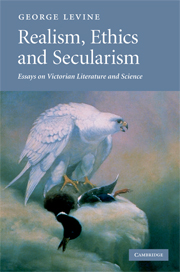Book contents
- Frontmatter
- Contents
- Preface
- Introduction
- Part I THE SUBJECT BROACHED: OTHERNESS, EPISTEMOLOGY, AND ETHICS
- Part II ETHICS WITHOUT GOD, OR, CAN “IS” BECOME “OUGHT”?
- Part III LITERATURE, SECULARITY, AND THE QUEST FOR OTHERNESS
- Chapter 7 Realism
- Chapter 8 Dickens, secularism, and agency
- Chapter 9 The heartbeat of the squirrel
- Chapter 10 Real toads in imaginary gardens, or vice versa
- Epilogue
- Index
Chapter 10 - Real toads in imaginary gardens, or vice versa
Published online by Cambridge University Press: 22 September 2009
- Frontmatter
- Contents
- Preface
- Introduction
- Part I THE SUBJECT BROACHED: OTHERNESS, EPISTEMOLOGY, AND ETHICS
- Part II ETHICS WITHOUT GOD, OR, CAN “IS” BECOME “OUGHT”?
- Part III LITERATURE, SECULARITY, AND THE QUEST FOR OTHERNESS
- Chapter 7 Realism
- Chapter 8 Dickens, secularism, and agency
- Chapter 9 The heartbeat of the squirrel
- Chapter 10 Real toads in imaginary gardens, or vice versa
- Epilogue
- Index
Summary
I believe that at the heart of Coetzee's manner, his style, his themes, there is a fundamental insistence on, a passionate demand for the real. Nobody, of course, is more self-conscious about the nature of narrative, about the fluidity with which words and things pass into each other, about the complexities of writing, or about the elusive and literary character of the real. Nobody is more quietly self-reflexive, more preoccupied with the problems of art and writing. Derek Attridge is obviously right to focus on the way the narratives in Elizabeth Costello are preoccupied with “what it means to commit oneself to a life of writing.” In Coetzee's recent novel, Slow Man, Elizabeth Costello appears as a character who, Bartleby-like, moves in on the main character, Paul, who thinks that she is watching him simply to get material for a novel; we watch her and him, sensing that it is all a novel that Costello is in fact writing under the hand of Coetzee, but compellingly engaged with what lies beyond words. It is dizzying in a Borgesian way.
But there is a sequence in Slow Man that focuses a particular and growingly important aspect of Coetzee's art and that might be taken as a central quality of what makes writing and life matter.
- Type
- Chapter
- Information
- Realism, Ethics and SecularismEssays on Victorian Literature and Science, pp. 261 - 269Publisher: Cambridge University PressPrint publication year: 2008



